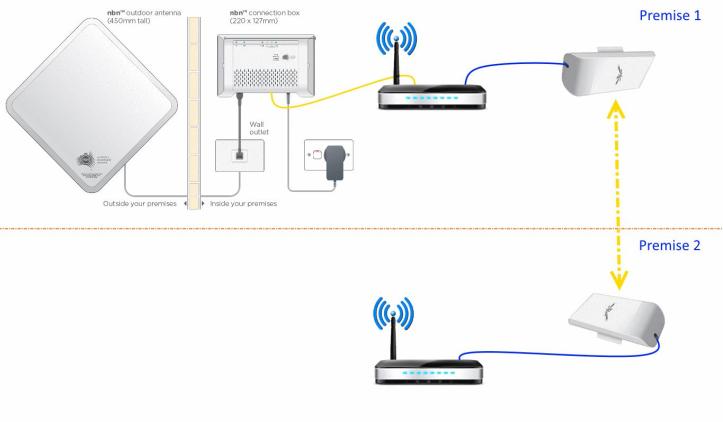Using a WIFI Bridge to achieve a nbn™ Fixed Wireless connection
The following diagrams show typical methodologies for connecting a remote nbn™ fixed wireless installation via a WIFI link.
The link is best constructed using semi-commercial specialist WIFI routers such as those made by Ubiquiti or MicroTik; or similar. This equipment is inexpensive and relatively straightforward to configure. You may also be able to purchase the equipment pre-configured, depending on the application. City Technology is a good place to compare Ubiquiti product pricing.
For links around 2 to 3Kms, an equipment cost of around $100 per site is likely. Installation and cabling is additional. Reliable links of up to 20Km may be economically realised. If the WIFI link is well designed and constructed it will provide speeds in excess of 100Mbps; which is more than fast enough for a 50/20Mbps nbn wireless connection.
OPTION 1: This arrangement shows an nbn™ fixed wireless service installed in a shed or location where no internet is required at that location (eg Premise 1 in the diagram below). The nbn™ service is extended via a WIFI bridge to the home (eg Premise 2 in the Diagram below) and a WIFI router is added to extend LAN services and broadcast WIFI around the home. The WIFI link acts exactly like a long, long length of LAN cable. For more in depth details read the stories on our Stories & Testimonials Page

OPTION 2: The second arrangement shows an nbn™ fixed wireless service installed in Premise 1 with internet available. This internet service is extended via a WIFI bridge to another premise, Premise 2. Both premises share a single nbn™ wireless service. Depending on configuration of the routers the premises may or may not share the same network. You may also configure the router to ensure that one household doesn’t swamp the others access ie each household is restricted to half the capacity of the FW link.

OPTION 3: This arrangement shows an nbn™ fixed wireless service installed in Premise 1 with internet available. A second nbn™ fixed wireless service is installed on the same nbn wireless NTU using the same or a different RSP (ISP/Provider). This second service is extended via a WIFI bridge to Premise 2. This second service is independent of the service at Premise 1 and is likely, separately billed.

There are two W-NTD versions. The V1 ODU has an antenna gain of 23dBi and a throughput capacity 60Mb/s. The V2 ODU has an antenna gain of 26dBi and a throughput capacity of 75Mb/s i.e. across one or all four ports.
An nbn™ fixed wireless service is available with speeds of 12/1, 25/5 and 50/20 (up to). This implies that if both customers were to activate a 50/20 service then there would be times when the service speed is restricted (by the 60-75Mbps total cap), if they are both heavy users.
Sharing between ports is graceful, as they are different vlans ie if you had port 1 and 2 activated with 50/20 plans, the throughput sharing would be 50:50.
OPTION 4: A fourth situation may exist where a single property has two residences, each with an independent fixed wireless standard installation. nbn™ will install a fixed wireless service at each residence
There will be other variations of these four themes.
Please note, while all care has been taken in compiling BIRRR documents, we recommend that you check with nbn™ or your ISP regarding your own connection issues. Thanks to John Kitchener, BIRRR member for compiling this document.

